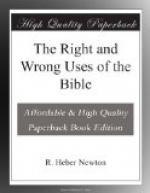The Book of Ezekiel supplies the missing link. The writer was a prophet-priest, who went into the exile, and wrote in Babylonia. In the earlier part of his life-work, recorded in the earlier portion of his book, he was thoroughly prophetic, intensely ethical and spiritual, breathing the very spirit of his great master, Jeremiah. In the latter part of his career he was visited with dreams, such as are plainly indicated to us in the remarkable vision occupying the concluding section of his book. The fortieth chapter opens thus:
In the visions of God brought he
me into the land of Israel, and set me
upon a very high mountain, upon
which was as the frame of a city on the
south.
Then follows, through eighteen chapters, a sketch of the temple system in the expected restoration. It is a thoroughly ideal sketch, a vision destined to take on much simpler and humbler proportions in its realization; a picture probably not intended for copying in actual construction, but, like all ideal work, a powerful stimulus to the aspirations it expressed.
It is a free sketch of the New Priestly System, on the easel, awaiting correction and completion at the hands of Ezra and others. It reveals to us the visions that were occupying the minds of the best men in the latter part of the exile, and the work they were essaying. Thus we are prepared for the final issue.
The Book of Daniel has been wrongly placed, traditionally, with most serious consequences to the character of the book, and, through this misconception to Christianity. Dated from the early part of the sixth century before Christ, its story of Daniel’s experiences read as literal history, and its visions appear as actual predictions of long subsequent events.
A high authority has declared—
There can be no doubt that it exercised
a greater influence upon the
early Christian Church than any
other writing of the Old Testament.[37]
That influence, owing to this misconception, is chiefly to be traced in the growth of an apocalyptic literature, and in the fantastical and material expectations of the Messianic Kingdom which they encouraged. It has continued down to our own day turning heads as wise as Sir Isaac Newton’s, setting religion at conjuring with visions of monstrous beasts and juggling with mystic figures until the name of Prophecy has become a by-word.
This book appears to take its proper place, at least in its present form, about a century and a half before Christ. That was a period of deep depression for Israel. Under Antiochus Epiphanes the nation had been sorely oppressed, its temple denied, and its religion well nigh crushed out. Men’s hearts were failing them for fear, and for looking for those things that were coming to pass upon the earth. Pious souls turned back to the ancient time of bitter humiliation, when Israel had been scattered in a strange land, and recalled the bold word of faith




